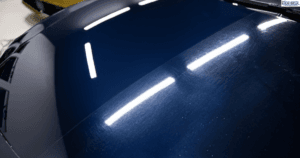When it comes to car detailing, window tinting is often chosen for its aesthetic appeal, privacy, and heat reduction. However, there are situations where removing window tint becomes necessary, such as bubbling, fading, or legal compliance. While many people consider tackling this project on their own, it’s essential to weigh the challenges and possible complications.
If you’re considering a career in detailing, window tinting, or even removal, professional window tint training and certification can equip you with practical skills and insights to perform these tasks confidently.
At Monster Detailing School, we offer comprehensive training using advanced techniques to ensure our students become industry leaders, providing services sustainably and effectively. Here’s a complete guide to removing window tint and deciding if DIY or professional help is best.
Related Blog: From Tinting to Drying: How Long Does the Window Tinting Process Take?
Why Remove Window Tint?
1. Legal Reasons:
Some regions enforce specific tinting laws. If your tint exceeds legal limits, you may need to remove or replace it.
2. Aesthetic Wear:
Over time, tints can bubble, peel, or fade, reducing your car’s aesthetic appeal.
3. Improved Visibility:
Removing a dark or deteriorating tint can improve visibility, especially at night.
The Challenges of Removing Window Tint Yourself
While DIY window tint removal may seem straightforward, it requires care, patience, and specific techniques to avoid damage to the glass or defroster lines. Plus, removing the tint adhesive is another challenge.
Pros of DIY Window Tint Removal
- Cost-Effective:
Removing tint yourself can save money on professional labor fees.
- Convenience:
You can do it at your own pace, without needing to book an appointment.
Related Blog: How Much Does It Cost to Tint Car Windows?
Cons of DIY Window Tint Removal
- Potential for Damage:
Without proper tools and techniques, you might damage your car’s glass, defroster lines, or interior surfaces.
- Time-Consuming:
Tint removal can be a lengthy process, especially if the adhesive is stubborn.
- Risk of Imperfections:
DIY removal can lead to uneven edges or adhesive residue, which may affect the final look.
Guide to DIY Window Tint Removal

If you’re ready to tackle this project yourself, here’s a basic method to follow. This approach requires simple materials, though specialized tools taught in professional window tint classes can make the job much easier and more efficient.
Tools Needed:
- Hair Dryer or steamer
- Razor blade or utility knife
- Spray bottle with soapy water
- Clean microfiber cloth
- Ammonia (optional, for stubborn adhesive)
Method:
1. Heat the Tint:
Use a hair dryer or steamer to warm the window tint. This loosens the adhesive, making it easier to peel off.
2. Peel the Tint:
Start at one corner, using a razor blade or utility knife to lift the tint film gently. Slowly peel the tint away from the glass, keeping it at a low angle to avoid tearing.
3. Spray Soapy Water:
If adhesive remains on the window, spray it with soapy water. Allow it to soak in for a few minutes to soften the residue.
4. Scrape Adhesive Residue:
Carefully scrape any remaining adhesive using the razor blade, keeping the blade at a shallow angle to prevent scratches.
5. Clean the Window:
Wipe down the window with a microfiber cloth to remove any leftover residue, leaving it clear and spotless.
When to Call a Professional
If the window tint is aged or extremely stubborn, or if you’re unsure about DIY, consulting a professional is the safest option. Here are some scenarios where professional assistance is recommended:
1. Complex Windows:
Rear windows with defroster lines can be delicate, and removing the tint without causing damage requires expertise.
2. Unusual Adhesives:
Some tints use industrial-strength adhesives that may not respond well to standard removal techniques.
3. Time Constraints:
Professionals can usually complete the job faster with specialized tools and techniques.
Why Consider Professional Training?
For those interested in the detailing industry, learning the proper techniques to install and remove window tint is a valuable skill. At Monster Detailing School, we try our best to provide hands-on training to master these techniques. By joining our program, you gain access to:
- Advanced Technology:
We use the latest tools and methods, helping students stay current with industry standards.
- Best Practices:
We teach our students practical, tested techniques, ensuring their work is safe, effective, and efficient.
- Comprehensive Multilingual Training:
Our classes cater to a diverse audience, making our training accessible and effective for everyone.
Our program is designed to equip students to provide high-quality detailing services and thrive as professionals in the industry.
Conclusion
Deciding whether to remove window tint yourself or seek professional help depends on the project’s complexity and your comfort level. For basic tint removal, DIY might be a cost-effective option, but professional help ensures quality results with minimal risk. For those pursuing a career in detailing, investing in quality window tinting classes can be a game-changer.
With Monster Detailing’s training, you can gain valuable skills in tint installation and removal, ensuring that every vehicle you work on meets the highest industry standards. Whether you’re a DIY enthusiast or an aspiring professional, understanding the techniques and best practices for window tint removal can help you achieve clear, flawless windows.
More Topics:










